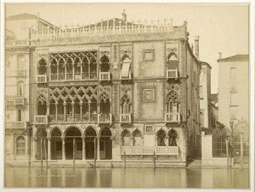Palazzo Detto Ca' Doro (The Ca' d'Oro)
Giovanni Battista Brusa (active 1860-1881). Photograph on paper, late 19th century
WorkThe accession date of this photograph is not known, but it was most likely purchased by Henry Swan's successor as curator, William White, during one of his Continental tours.
ArtistThe Italian photographer, Giovanni Battista Brusa, was responsible for a large number of detailed Venetian views. Other examples of his work can be viewed on the following web pages:
Collection of the Guild of St George, Museums Sheffield
The Ca' d'Oro today, © Marcus Waithe, 2010 (an album bound by Brusa's studio, uploaded to http://www.annona.de)The Ca' D'OroIn contrast to the palaces built by in other Italian cities, those in Venice were modest. The architectural historian, Deborah Howard, observes that 'even the grandest palaces were known simply as case, or houses, often shorted to ca', the title palazzo being reserved for the Palazzo Ducale' (Howard, The Architectural History of Venice, rev. edn, Yale UP, 2002, p. 36).As its name suggests, The Ca' D'Oro (House of Gold), was an exception. Its original owner, Marino Contarini, was set on making an impression, and the external decoration was lavish. The site was previously occupied by a Veneto-Byzantine palace owned by the Zen family. Although this was demolished, fragments of it were absorbed into the new facade. Two stonemasons were involved, Matteo Raverti, who was a Milanese sculptor, and Giovanni Bon, a Venetian. Howard attributes the external staircase in the courtyard, the portal street entrance, and the six-light window of the piano nobile, to Raverti (p. 104). She attributes to Bon's workshop the four-light window inside the waterfront portico, the single windows with balconies on the facade, and the cornice and crowning pinnacles. Ruskin on The Ca' D'OroRuskin wrote to his father in September 1845 to complain of restoration work being performed on the Ca' d’Oro. He complained of 'vainly attempting to draw it while the workmen were hammering it down before my face' […] and just as I am becoming able to appreciate it, and able to do something that would have kept record of it, to have it destroyed before my face!’ (Works, III, p. 214). Ruskin knew that remnants of the original gilding had been removed from the lions guarding its balconies at that point (Works, 3, p. 214). Even so, he was able to summon up enthusiasm for 'the beauty of the fragments left’ (Works, 3, p. 214).Further restorations were undertaken after the house fell into the hands of the ballet dancer, Taglioni in 1847. During restoration work in 1851-2, Ruskin would see the marble bases of its balconies ‘dashed to pieces’ (Works, 11, p. 371). By the time of his Venetian Index to the Traveller's Edition of The Stone of Venice (1881), Ruskin was writing of the building as ‘once superb in general effect’, but ‘destroyed by restorations’ (Works, 11, p. 370). When the building was restored again, by Baron Franchetti in 1896, the aim was to undo the damage inflicted by these restorations of Giovanni Meduna, earlier in the century. |



















